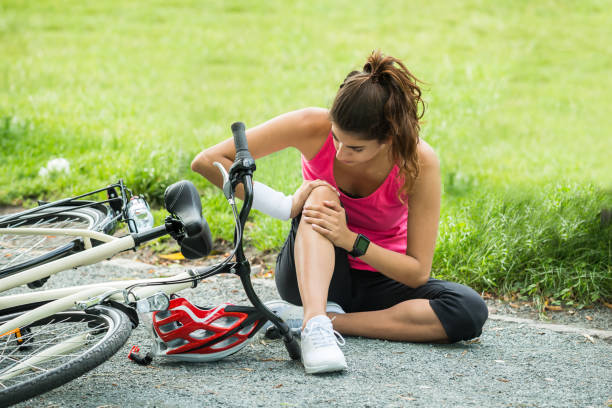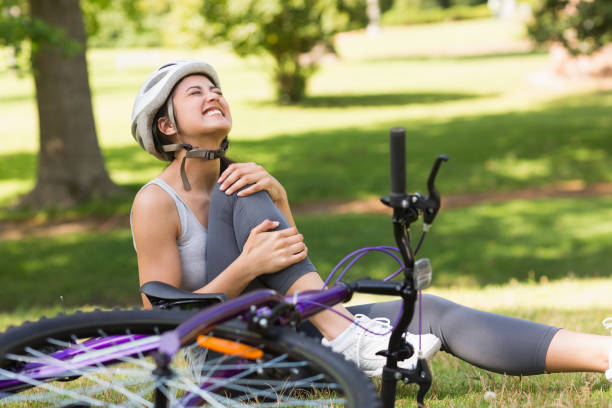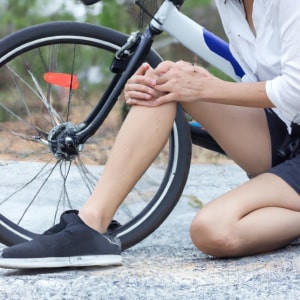Cycling front knee pain is extremely common during the cycling season. Unfortunately, it requires rest to heal, as do other cycling injuries and ailments. But, if you rest and correct any underlying bike fit issues, you should be able to ride your bike for many miles this summer. Most cyclists, from beginners to pros, will encounter knee pain when riding at some point in their careers.
Table of Contents
ToggleThe Knee is a Complicated and Problematic Joint | Cycling Front Knee Pain
It’s critical to understand that the knee serves as a hinge between the hip and the ankle. It is quite rare for the problem to be with the knee itself. Because it involves so many body parts, the discomfort is often limited to the knee. Still, you should also consider the ankle, hip, and lower back. Because it is so intricate, it is ideal for treatment because it has a high response rate.
Pain in the Front of the Knee (Anterior Knee Pain)

Anterior knee pain is a term used to describe pain in the front of the knee. Its cause is usually tension in the quads or the Iliotibial band. The iliotibial band is a fibrous tissue that runs alongside the outer thigh and pulls on the knee cap. This might be due to improper bike fit or tightness caused by a lack of maintenance or misuse. The main thing to look at is the patella (knee cap). Everyone talks about patella tracking, or patella dysfunction, which is how the knee cap slides over the joint. Many people report that the knee cap becomes stuck, clicks, or dislocates.
Usually, the knee cap does not cause problems on its own. If there are no quadriceps attached to the knee on both sides, it would fall off. If one side is tight, it pulls the patella up or down, causing it to dislocate and causing pain. Cyclists use their quadriceps the most in the downward stroke, this places a lot of strain on the knee. The pedalling action affects your quads. You can observe this in advanced cases in a pattern known as ‘Kermit the Frog Syndrome.’
Some cyclists appear to have steel-like quadriceps and IT bands. During bike fits, we see folks pedalling with their knees out despite the fact that their cleats are straight. The quadriceps have been overworked to the point that the muscle is short, and the only way to get the leg to pedal properly is to pull them out.
If you treat it in the early stages you can reduce the pain. But, if left alone, it can have long-term consequences. Cycling Front Knee pain can happen due to damage to the meniscus or cartilage. Usually, it is due to trauma or injury, but it can also develop from repetitive movement. If you keep cycling with your knee in the incorrect position for a long time, it could lead to irritation in the tendons that attach the knee cap and quads. You will intense pain there where the tendon becomes inflamed. And if left untreated this condition can spread around the knee.
How to get rid of Anterior Knee Pain?

So, what can we do about cycling front Knee pain? First, make sure your bike is fitted according to your physique. Usually, the front cycling Knee pain is due to the saddle being too low and too far forward. Racers believe they get more power down that way, with their teeth on the bars. But doing this means they’re sitting on top of the knee and pushing a lot of stress into it. Cranks that are too long can also generate an improper angle. At the same time, cleats that are too tight can cause strain from repetitive unclipping.
 Tightness, whether it’s due to a poor bike fit or from long-distance cycling, you can solve it with foam rolling and stretching. Stretch the affected muscle and relax the buttocks with a massage. This will help release some of the tension, then foam roll gently.
Tightness, whether it’s due to a poor bike fit or from long-distance cycling, you can solve it with foam rolling and stretching. Stretch the affected muscle and relax the buttocks with a massage. This will help release some of the tension, then foam roll gently.
Foam roll the quads, the inside of the thigh, and the IT band; do all the rolling at a slow speed. Sometimes people move up and down like a rolling pin, but that merely flushes over the strands and doesn’t really solve the problem. The whole process needs to be one continuous smooth and progressive push through the fibers to add some length to the muscle.
Kinesio tape the tape that doctors or medics use to enhance blood flow to an injured location. You can also use it to force the patella into the proper position. The tape returns the knee to its proper position. All you need to do is to make the tense muscles relax so that the knee returns to its normal position. Taping is a fast remedy, but it does not work long-term.
Pain in the back of the knee (Posterior Knee Pain)
While the quadriceps frequently cause discomfort at the front of the knee. But the pain in the back of the knee, known as posterior knee pain, is usually due to the hamstrings. The saying in bike fitting is ‘pain in front of the knee; the saddle is too low. Discomfort in the rear of the knee; the saddle is too high. That’s the easiest thing to look at first in terms of bike fit.
Posterior pain can also be due to overextension. For example, if the saddle is too high, the muscles are too tense, and the knee can’t cope with that degree of flexion. The hamstrings are being strained, causing pain in the hamstring and where the muscle inserts around the knee. An overly high saddle can put undue strain on the lower back. This causes the hamstrings to shorten. They can pull on the pelvis if put under too much pressure. The quads then try to counterbalance this, which can result in hip movement and a leg length discrepancy, which can put pressure on the knee.
How to get rid of Posterior Knee Pain?
The first thing you should do if you have posterior knee pain is to check your saddle height and fore/aft – being too high and too far back could be the cause. Use icing and more foam rolling for treatment. After that, foam roll and stretch the posterior chain, including the hamstrings, calves, and glutes. And stretch – hanging your heel off the back of a step helps. Or you can also shift forward on the bike and stretch your calves and hamstrings for about ten seconds by hanging your heel off the pedal.
Medial Knee (inner knee pain) and Lateral Knee (outside knee pain)
Other causes of Knee in bike Fit
Though saddle height, offset, and cleat configuration is all common causes of knee pain. There are a few other factors to consider. For example, a saddle sore can cause a rider to sit off-center. This can result in an incorrect position as the pelvis shifts and gives the appearance of a leg length discrepancy. Low handlebars could be a contributing factor if the lower back becomes fatigued, altering the natural movement pattern. Tinkering with your setup may help, but if your issues become chronic, there’s no substitute for a physio-led bike fit.

